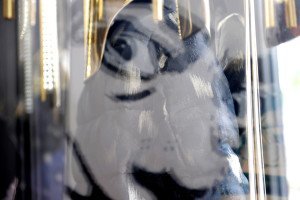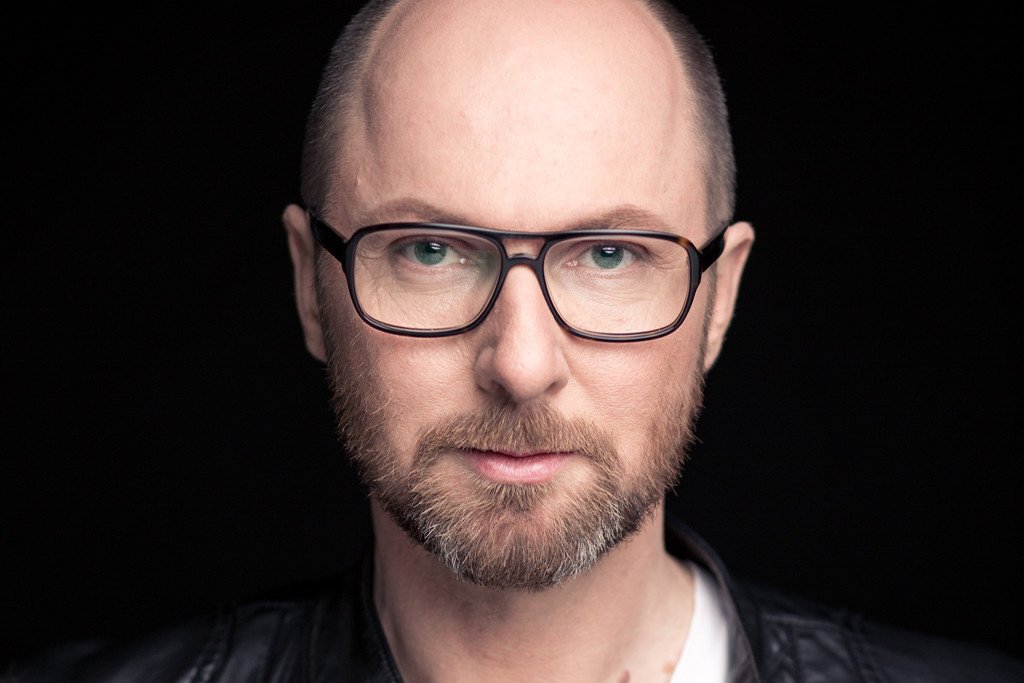
Nik Pichler: reflections of feelings and life
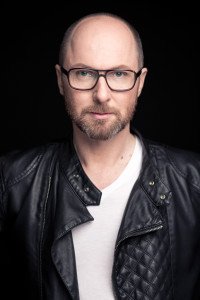 [leggi l’intervista in Italiano] We meet Nik Pichler, photographer; not as a reflection of a wonderful moment on a glass, as in his pictures, this time, but in real life, in Caffè San Marco – in Trieste. Nik, born in October 1970, lives in beautiful Vienna, and works in Vienna and Europe and in New York. We meet with him and with concepts and feelings in his ‘Reflection’ photography, and the recent exhibition ‘Steve and Me – Pop Art meets Reflection Art Photography’ , inspired by Steve Kaufman work, life and art. And we meet a great photographer, a wonderful and sensitive person, who talks with simplicity, and great passion, about his work and his experiences, showing us, once more, the importance of emotions.
[leggi l’intervista in Italiano] We meet Nik Pichler, photographer; not as a reflection of a wonderful moment on a glass, as in his pictures, this time, but in real life, in Caffè San Marco – in Trieste. Nik, born in October 1970, lives in beautiful Vienna, and works in Vienna and Europe and in New York. We meet with him and with concepts and feelings in his ‘Reflection’ photography, and the recent exhibition ‘Steve and Me – Pop Art meets Reflection Art Photography’ , inspired by Steve Kaufman work, life and art. And we meet a great photographer, a wonderful and sensitive person, who talks with simplicity, and great passion, about his work and his experiences, showing us, once more, the importance of emotions.
We start with the difficult one. Who are you, Nik?
Ok! Who am I? I think I am a person who observes lot of things. A person that has the ability to observe. I am a person who trust his stomach feeling and takes a pic only when the feeling is the right one. I am very curious. Open.What’s the meaning of ‘open’, for you?
‘Open’ means … that I am really interested in other people, in them, and I always like to understand them and their world. And maybe not only understand, but also to feel. With the camera, or without it. This is also part of what I am. I can put myself outside everything and really try to understand. To look at the whole thing.
Henri Cartier-Bresson used to say you need to be part of what you see through the viewfinder of the camera and look with open eyes. Be part of the picture, feel involved.
For example, when I do a portrait in my studio, I invite people earlier, I talk to them half an hour before the shooting. We sit together around the glass table, we talk, and only after that I take the camera. And then, in ten minutes, I’m finished.
Don’t think and don’t set up; just do it.
Absolutely. For me, ‘photography’ is not ‘technique’. The technique in all photography is already perfect. You have to know it, but there’s nothing else with it.
You are quick.
I am very quick. My assistants prepares the lights and the other stuff. I don’t do the studio set up because I take all the available time to look at the personality of the person I have to portrait.
When I’m doing a portrait, people comes to my studio and as first, we set up lightning. I know already, in my mind, which light I will take as a first step. Then they have the makeup. While we are doing the makeup, we talk about the whole stuff, another twenty minutes, half an hour: and then on the set, another ten minutes, and it’s done. When they know it will be over in ten minutes, they are very happy, they really like to have the real shot after ten minutes. For some people … I need to make it longer …
Otherwise they don’t trust you. Too quick to be a professional.
Exactly. So, I take the shots, and we use more time, maybe another half an hour, to do something else and some other picture. But I know already that the shot I’ll use it’s the one from the first minutes.
I also noticed that people, if they don’t have a professional camera in front of them, well – they look at you strangely. So – I indeed use very professional equipment. I have to create a ‘professional bubble’ for them, a bubble that I really won’t need – and when they are inside it, they feel comfortable.
The whole Steve Kaufman project we have in this exhibition we open now in Vienna – we exhibit ten pieces: eight pieces were shot in forty minutes. In these forty minutes, though, I was concentrated and felt tired as I have been working for three days.
How did the Reflection photography start? And where?
The first time I did ‘Reflections‘ was a coincidence in Paris. I was bored; I was in Paris for eighteen hours, and I was looking at a shop window. Bored. Then, I changed my perspective in that window, and everything began.
It was in 2012. A couple of weeks before I had been in Mongolia, invited by Mongolian government to do a shooting in the Western region related to Shamanic culture, a documentary work. They wanted me to do an exhibition in Vienna with those pictures, related to Austrian-Mongolian cooperation. At the same I was opening my gallery. I thought it was a big bang, so – a great opportunity. Then … it was postponed due to government issues, and I had two weeks more before my opening, and that’s why I went to Paris in the first place. So, you see … I was bored, no enthusiasm, then I just changed my perspective and looked at things differently, and the whole ‘Reflection’ experience started.
I came back from Paris with some pictures I wanted to show. Some people in art, in Austria, advised me against that, telling: ‘Don’t do this kind of photography right now. It’s too complex, you can do best’. But I said to me: I trust my stomach. It feels good to me, I want to do it and I will do it. And I did it.
They believed ‘Reflections’ to be too much innovative?
No, actually they said those pictures, in their opinion, contained too many things, and were sending multiple messages. But I didn’t care about how many messages. Right now, actually, I don’t care about any political message in my pictures. In the ‘Reflection’ I combine the thing behind the window, with the thing in front of the window. You don’t know what is behind and what is in front. This is my emotion. What I see, where I stand … I need to be into this emotion.
Basic fact was that at the time ‘Reflection’ started, they were much different from the pictures I used to do before. But it felt right, and I did it – which you know, for me it’s a big investment, all the time, because I print my pictures on glass. But in the first evening, I sold fifteen pictures. It was great. The first picture I sold to a person connected to Swarovsky; he was so happy with that picture because it was something new for him. Swarovsky texted back that they wanted me to work with the company. I was not sure, in the beginning, because you know – a discussion at an opening is not the same as a formal one. But couple of weeks later, Swarovsky representative flew in from Switzerland and we met. So the cooperation started.
I remember my deadline at the time. Set to February. Time was passing, and I had no light the whole winter. Long story short – I trusted my feelings once more, I knew the moment will come. And it came, five days before the deadline. I went down to Vienna and I shot the whole thing in two hours. Then I sent them thirty pictures. And it was done. Same old special feeling. It also consists in the light I see and everything, but most of all, it is within me – that feeling that tells you: ‘Now it’s the right time’.
How’s the light in Vienna?
Terrific. The architecture, and the cool light in winter – it makes everything special.
But nothing works, if I am not in the right mood.
I had an idea about what to do, when I flew to Los Angeles. I knew the background with Alberto Panizzoli and Diana Vachier of American Pop Art but didn’t have a project, I wanted to see and feel the things first. Then I was in Steve Kaufman studio … and it all became emotion. I felt that I needed to bring Steve back to the streets of Los Angeles – on his streets. He walked those streets. He lived there.
I put his pictures on the streets of Los Angeles. I asked to re-frame his pictures, to put it on the asphalt of Los Angeles … the asphalt has a wonderful structure there, it’s very tough, rough. I wanted to have the pictures there during a traffic day, and I was using the short time when the traffic light was red. Traffic light was red – someone ran, and put the picture there. I ran too, to take the picture, because I wanted to be on the floor … and it was just one minute because then cars started to drive. And what we did was … amazing. Melrose Avenue, full of cars, hundred of cars. Steve Kaufman back on his streets. An accident had happen right there, short before, with all this broken glass. I lied down on the glass – I was so concentrated I didn’t notice it at first.
People and everyone was looking at me as if I was a little … well, out of my mind. They trusted me, but they thought: “What is he doing now, since, actually we want to have a Reflection picture”. And … it worked. It was fun, and it was emotion, and it was one of the most beautiful days we had together. We were four and everyone of us was needed.
I needed to bring Steve Kaufman down, before to lift him up.
 Why photography? How did you start?
Why photography? How did you start?
‘How I started’ … it’s easy. I started with a very small camera; at the beginning I had no photography education, I just had that small Minolta camera – a pocket camera – and I did a lot of photos. Then, my friends asked me to do other photos, because they were good, and it was funny. And then … and so on, and so forth.
I actually started to do photography more seriously when I got a bigger camera as a birthday present; I was thirty. I just started shooting – I had so much pictures in my head and I wanted to bring them out. This – to bring things out – is also the basic reason why I do photography. I see lot of things, and I see the moments – the light, and the lines, and the combinations. I needed some media to get it out of my mind. And that media was the camera.
 My photos before my birthday and before the ‘camera present’ were on film, analogue. Then I got courses and training sessions because I wanted to learn more things.I also learnt how to develop the film, et cetera … but, I couldn’t do it. I wasn’t so fond of it, it’s very technical, time consuming – I wanted to know how to do it, but I prefer the emotion of the moment.
My photos before my birthday and before the ‘camera present’ were on film, analogue. Then I got courses and training sessions because I wanted to learn more things.I also learnt how to develop the film, et cetera … but, I couldn’t do it. I wasn’t so fond of it, it’s very technical, time consuming – I wanted to know how to do it, but I prefer the emotion of the moment.
Do you like enhancement techniques and post processing?
I don’t like Photoshop … well, you could get me wrong when I say this. I actually like Photoshop, but an original picture is an … original picture, and every time you touch something on it, you lose something else. In the ‘Reflection’ photography we need to work on contrast, we need to work with lights a bit, but we are not working or touching any other layer. Except portraits, when the lady says: ‘you have to do it’. But even then, I advise not to apply it so much.
People thinks the better the technique is, the better the photo would look, but it’s not so. I don’t like Photoshop post processing and I’m not fond of technical perfection, not at all. Photography has nothing to do with it. You don’t need to have the perfect camera, you don’t need to have all the best equipment – I mean, those things are really good … but … you shouldn’t care about it too much. I asked once to Swarovsky why they took me. And they said they were very impressed by the fact I concentrate on the emotion and that I don’t Photoshop my pictures.
So you don’t like World Press Photo awards, I assume.
It’s not mine. I like it, I like to watch it, but I also observe that everyone becomes too much obsessed with the development of techniques and the stunning effect in the picture. Too much obsessed.
Would you prefer studio work, or working on the streets?
Both. But my studio work is quite crazy. I always have loud music – I like it. And it’s always very funny. For business portraits it is sometimes very funny when the manager stands there looking strangely and I say: ‘Oh, I like to build up this rolling thing’. But they know me by now – and they know the result is good.
So – I like both. But as I told, I don’t like very much to do lights and preparation. If I do that, I lose the contact with the client. I have my assistants and it’s wonderful, they know what to do.
In portrait photography, personal feelings are the most important for me. And sometimes, also, they show me too much. I made something, some picture, that I will never be allowed to publish because it’s too personal. They tell me they prefer not to use it – and it’s ok.
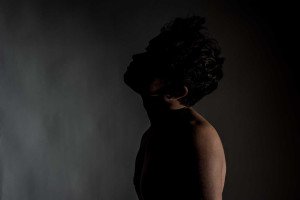 The big advantage we have in photography compared to the drawing art is the instant. And that is what I like most.
The big advantage we have in photography compared to the drawing art is the instant. And that is what I like most.
Drawing or painting, you don’t have that special moment – you can think. You can elaborate. The photographer needs to have the ‘click’ on that special moment only. If you start thinking about technique, that special moment is over.
I will never do shootings which I need to prepare too much.
I did a Brazilian male model recently. Suddenly the lights went out. I continued shooting, I focused on the shadow. And this is the special moment – this was the very personal moment, the person and the shadow itself, and the interaction.
So again, the advantage of photography in art is the moment. If you came close to an obsession for technique, then you became kind of a painter: you think too much, you work too much in Photoshop … in the end you are not a photographer. And also you don’t need to take one hundred photos of the same scene in few moments.
Would you remember a moment that was terrible for you?
I’m not quite sure if it’s … terrible, but comes up in my mind, you know? I was invited to a special event, and … well, I did not like some of the participants. Didn’t like them all. It was for a very good reason. I could manage to take photos of the event, but none of this people. And then, when they asked about the pictures, I said: ‘I am sorry, I have no clue about what happened! I don’t have”. You know, I would never let these people in my camera. Never. Again, for a very good reason.
The worst moment at all I experienced, I think … then turned out to be good. I made a very difficult shooting for a very special person. And I didn’t save the pictures immediately on my computer, as I always do. I was in rush, and everything had been difficult that day, and I left the pictures on the flashcard – said to my assistant: “Just give me the card, and we save the pictures next day”. The following day we put the card into the camera, and the camera message said: ‘broken card’. And … I felt terribly. But then, on my other camera, it worked. It was a defect on the camera, not on the card: photos were safe. Save your photos immediately. Always!
 What about the Pop Art movement? You have been working with Steve Kaufman legacy very recently, and it’s your most recent event.
What about the Pop Art movement? You have been working with Steve Kaufman legacy very recently, and it’s your most recent event.
I love it. It reduces the difficult things into very simple things. When I look at the eyes of Marilyn Monroe for example, I understand you could paint it in a very difficult way, or you can paint it in a very easy way. Steve Kaufman, for example, painted for us in an easy way. And it makes you happy to look at it.
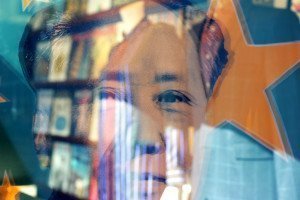 For me, Pop Art is also the other way around: it’s wonderful basis to make the simple things complicated. It gives me the basis to create something new. This is the painting of Mao, inspired by Steve Kaufman art. I call this picture: “The books of Mao”, because in my ‘Reflection’, in Mao’s mind are books. And during Mao’s time, books were strictly forbidden.
For me, Pop Art is also the other way around: it’s wonderful basis to make the simple things complicated. It gives me the basis to create something new. This is the painting of Mao, inspired by Steve Kaufman art. I call this picture: “The books of Mao”, because in my ‘Reflection’, in Mao’s mind are books. And during Mao’s time, books were strictly forbidden.
Then I did another one, and I called it ‘Trapped lady Liberty’ because there’s ‘Liberty’ from Steve Kaufman, which he already divided in red and blue, and I divided it again in a window and I could frame the rest of the space, as in a cage. ‘Lady Liberty’ – the American dream – and actually, it’s a trap.
This picture with Fidel Castro is my statement on Communism. And now I have a political statement, which I usually did not do in the past. I am developing my message. I think I needed the basis, which is not so political, to create something political.
In Steve Kaufman studio, in talking with Diana Vachier, there’s something very touching. There’s a real good energy about this person, Steve Kaufman.
What did you feel when you were in Steve Kaufman studio?
It was like ‘Alice in Wonderland’. You walk into the studio, into his ‘factory’, and you have the impression he just left, that you just missed him for five minutes. Everything is there. And it’s that feeling that makes everything so special. You’re not in a museum. It’s energy. Freedom. Wonderful chaos. And definitely no stress. I also think he was a really funny person.
Austria in the heart of Europe, and USA. Two different worlds. How would you describe the duality?
Absolutely different. How to describe the difference, and the connection? Well, as first we need to think about USA as such big country that the two Coasts, Los Angeles and New York, are completely different. My second home is New York, I love it . For me, Vienna, or Europe … it is ground. Roots. And sometimes these roots are too heavy, you know? Things does not move that fast, in Europe.
When you arrive in New York, instead, all is pure energy. You can achieve everything: you just have to have the guts. A friend said to me: ‘New York forgives everything apart having no guts’. And that’s true, and I learnt it. I was doing an interview, in a TV show, and this interview went very well – the producers were asking me if I’d like to have my own TV show there. Wow. Two days later I was sitting in this apartment close to Central Park with a lady and a guy – cool people, very important people – and I was presenting the idea of what the TV show could be. I was thinking and thinking about how to make a good impression, what words to use, and how to talk about my idea and the way I’d like the TV show to be, and … I felt unsure. But then I was saying to myself: ‘Oh hell, in two days you are back to Vienna, so what could possibly happen? Just tell them your idea, and let it be’. They were listening, very carefully, asking no questions – I will never forget that – and … at the end, it was me who asked: ‘And? Do you like it?’ They just said: ‘We like it and we’re gonna do it’. I said back: ‘… Ok’. That was it.
In our countries, you would have to describe the concept first, then say where have you been before, what are you going to do in your future, who supports you … there, in New York, it’s like snapping fingers, and if the idea is good it happens. Then another two days later they sent me the first application of artists – it’s a show about art – and they told: “This is the first list of guests, check it out, let us know the ones you prefer” – “… don’t you want to choose too?” (that is Europe: people likes to influence here, there … say something about everything … ) “No – this is your show. You present it, you know how to do it”. This is New York.
Which one of the two worlds would you need most?
I need both of them. Being in New York means living all the time 120%.
Really.
Here in Europe, in Vienna, I calm down. Friendships are different. Personal connections are different. But … things happens, in New York. I think that to live a dream here it’s more difficult than there.
What would you suggest to young photographers or people who is just starting their career, or their passion, now?
Sometimes I’m asked – and I never do it – to talk to photographers, to have workshops with them and teach. I don’t do it – because I think they would be disappointed with me. I would say to them at first: leave the camera, leave the equipment, you don’t need it – don’t be insecure, don’t think about it, don’t think about composition, rules, techniques … just watch, observe, feel photography, it’s just you. It’s just catching a moment, the right moment.
Live it.
Roberto Srelz © centoParole Magazine – all rights reserved
(images copyright © Nik Pichler)
Blog: blog.nikpichler.com
Facebook: www.facebook.com/nikpichler
Instagram: http://instagram.com/nikpichler

